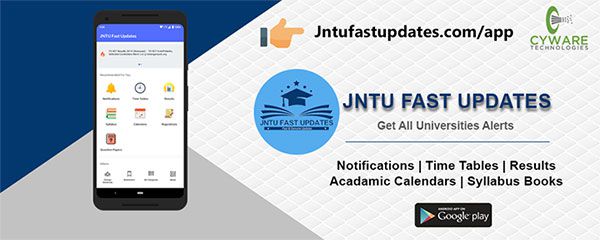JNTUK R19 3-2 Digital Signal Processing Material/Notes PDF Download
Students those who are studying JNTUK R19 ECE Branch, Can Download Unit wise R19 3-2 Digital Signal Processing (DSP) Material/Notes PDFs below.

JNTUK R19 3-2 Digital Signal Processing Material/Notes PDF Download
OBJECTIVES:
- Analyze the discrete-time signals and systems in time and frequencydomains.
- Know the importance of FFT algorithm for computation of Discrete FourierTransform
- Understand the various implementations of digital filterstructures
- Learn the FIR and IIR Filter designprocedures
- Learn the concepts of DSPProcessors
UNIT-1
INTRODUCTION: Introduction to Digital Signal Processing: Discrete-time signals & sequences, Classification of discrete-time systems, stability and causality of LTI systems, Response of LTI systems to arbitrary inputs. Solution of linear constant coefficient difference equations. Discrete-time Fourier Transform (DTFT), Frequency domain representation of discrete-time signals and systems. Review of Z-transforms, solution of difference equations using Z-transforms, Systemfunction.
Download UNIT-1 Material PDF | Reference-2
UNIT-2
DISCRETE FOURIER SERIES & FOURIER TRANSFORMS: Properties of discrete Fourier series, DFS representation of periodic sequences, Discrete Fourier transforms: Properties of DFT, linear filtering methods based on DFT, Fast Fourier transforms (FFT)-Radix-2 decimation-in-time and decimation-in-frequency FFT Algorithms, Inverse FFT, Circular convolution and linear convolution using DFT.
Download UNIT-2 Material PDF | Reference-2
UNIT-3
DESIGNOF IIRDIGITAL FILTERS& REALIZATIONS: Analog filter approximations – Butterworth and Chebyshev, Design of IIR Digital filters from analog filters, Design Examples, Analog and Digital frequency transformations. Basic structures of IIR systems, Transposed forms.
Download UNIT-3 Material PDF | Reference-2 | Ref-3
UNIT-4
DESIGN OF FIR DIGITAL FILTERS & REALIZATIONS: Characteristics of FIR Digital Filters, Frequency response. Design of FIR Digital Filters using Window technique and Frequency Sampling technique, Comparison of IIR & FIR filters. Basic structures of FIR systems.
Download UNIT-4 Material PDF | Reference-2 | Ref-3
UNIT-5
INTRODUCTION TO DSP PROCESSORS: Introduction to programmable DSPs: Multiplier and Multiplier Accumulator, Modified bus structures and memory access schemes in P-DSPs, Multiple Access Memory, Multiported memory, VLIW architecture, Pipelining, Special addressing modes, On-Chip Peripherals.
Architecture of ARM processors: Technical details of ARM Processors, Introduction to Cortex-M3 and cortex M4 processors – Processor type, processor architecture, instruction set, block diagram, memorysystems.
Download UNIT-5 Material PDF | Reference-2
TEXT BOOKS:
- Digital Signal Processing, Principles, Algorithms and Applications: John G. Proakis, Dimitris G. Manolakis, Pearson Education/PHI,2007.
- Discrete Time Signal Processing, A. V. Oppenheim and R. W. Schaffer,PHI,2010.
- Digital Signal Processors, Architecture, Programming andApplications, B.Venkataramani, M. Bhaskar, TMH,2002.
- Digital Signal Processing Using the ARM Cortex M4, Donald S.Reay,2015.
REFERENCE BOOKS:
- Digital Signal Processing: MH Hayes, Schaum’s Outlines, TMH, 2007.
- Fundamentals of Digital Signal Processing using MATLAB – Robert J. Schilling,Sandra L. Harris, Thomson, 2007.
- Digital Signal Processing, Alan V. Oppenheim, Ronald W. Schafer, PHI Ed., 2006
- Digital Signal Processing, Tarun Kumar Rawat by OXFORD Publishers
OUTCOMES:
- Apply the difference equations concept in the anayziation of Discrete time systems
- Use the FFT algorithm for solving the DFT of a given signal
- Design a Digital filter (FIR&IIR) from the given specifications
- Realize the FIR and IIR structures from the designed digital filter.
- Use the Multirate Processing concepts in various applications (eg: Design of phase shifters, Interfacing of digital systems…)
- Apply the signal processing concepts on DSP Processor.

320-x100(1).gif)
